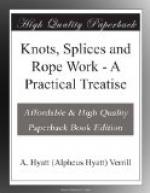Through countless ages the various forms of knots and fastenings for rope, cable, or cord have been developed; the best kinds being steadily improved and handed down from generation to generation, while the poor or inferior fastenings have been discarded by those whose callings required the use of cordage.
Gradually, too, each profession or trade has adopted the knots best suited to its requirements, and thus we find the Sailor’s Knot; the Weaver’s Knot; Fishermen’s knots; Builders’ knots; Butchers’ knots; and many others which have taken their names from the use to which they are especially adapted.
In addition to these useful knots, there are many kinds of ornamental or fancy knots used in ornamenting the ends of ropes, decorating shrouds of vessels, railings, and similar objects; while certain braids or plaits, formed by a series of knots, are widely used aboard ship and on land.
In many cases ropes or cable must be joined in such a way that they present a smooth and even surface and for such purposes splices are used, while knots used merely as temporary fastenings and which must be readily and quickly tied and untied are commonly known as “bends” or “hitches.” Oddly enough, it is far easier to tie a poor knot than a good one, and in ninety-nine cases out of a hundred the tyro, when attempting to join two ropes together, will tie either a “slippery” or a “jamming” knot and will seldom succeed in making a recognized and “ship-shape” knot of any sort.
The number of knots, ties, bends, hitches, splices, and shortenings in use is almost unlimited and they are most confusing and bewildering to the uninitiated. The most useful and ornamental, as well as the most reliable, are comparatively few in number, and in reality each knot learned leads readily to another; in the following pages I have endeavored to describe them in such a manner that their construction may be readily understood and mastered.
The author.
January, 1917.
CHAPTER I
CORDAGE




